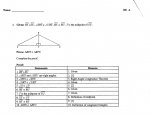You are using an out of date browser. It may not display this or other websites correctly.
You should upgrade or use an alternative browser.
You should upgrade or use an alternative browser.
**2 Column Proof Help??**
- Thread starter careness
- Start date
arthur ohlsten
Full Member
- Joined
- Feb 20, 2005
- Messages
- 847
RS=RU given
angle SRT = angle URT given
RT is common to both triangles
triangle SRT = triangle URT.............. side angle side
Arthur
angle SRT = angle URT given
RT is common to both triangles
triangle SRT = triangle URT.............. side angle side
Arthur
fasteddie65
Full Member
- Joined
- Nov 1, 2008
- Messages
- 360
I respectfully disagree with the answers given in the previous post.
The reason for [1] is "Perpendicular lines form right angles." This is usually a theorem. It is NOT the definition of perpendicular lines.
The reason for [2] is "If two sides of a triangle are congruent, then the angles opposite those sides are congruent." This is also a theorem, sometimes called the Isosceles Triangle Theorem.
The reason for [3] is "Reflexive Property of Congurence."
The reason for [1] is "Perpendicular lines form right angles." This is usually a theorem. It is NOT the definition of perpendicular lines.
The reason for [2] is "If two sides of a triangle are congruent, then the angles opposite those sides are congruent." This is also a theorem, sometimes called the Isosceles Triangle Theorem.
The reason for [3] is "Reflexive Property of Congurence."
thanks, your answer made sense.fasteddie65 said:I respectfully disagree with the answers given in the previous post.
The reason for [1] is "Perpendicular lines form right angles." This is usually a theorem. It is NOT the definition of perpendicular lines.
The reason for [2] is "If two sides of a triangle are congruent, then the angles opposite those sides are congruent." This is also a theorem, sometimes called the Isosceles Triangle Theorem.
The reason for [3] is "Reflexive Property of Congurence."
Hello, careness!
Who wrote this problem?
It is very badly written and its purpose escapes me.
The problem is severely overstated.
. . In an isosceles triangle, the bisector of the vertex angle
. . is always perpendicular to the base and always bisects the base.
So there are several possible proofs **
. . and they picked one which asks rather pointless questions.
Line 2 asks: Do you know how to say "Perpendicular lines form right angles" ?
Line 5 asks: Do you know that "Base angles of an isosceles triangle are equal" ?
Line 9 asks: How do you say "A thing is equal to itself" ?
~ ~ ~ ~ ~ ~ ~ ~ ~ ~ ~ ~ ~ ~ ~ ~ ~ ~ ~ ~ ~ ~ ~ ~ ~ ~ ~ ~ ~ ~ ~ ~ ~ ~ ~
**
\(\displaystyle \text{Another proof:}\)
.\(\displaystyle \begin{array}{cccc} & \text{Statement} && \text{Reason} \\ \hline (1) & ST = TU & & \text{def. of midpoint} \\ (2) & RS = RU & & \text{Given} \\ (3) & RT = RT && \text{Line 9} \\ (4) & \Delta RTS \cong \Delta RTU && \text{s.s.s} \end{array}\)
\(\displaystyle \text{And another:}\)
. . \(\displaystyle \begin{array}{cccc} & \text{Statement} && \text{Reason} \\ \hline (1) & RS = RU && \text{Given} \\ (2) & \angle SRT = \angle URT && \text{Given} \\ (3) & RT = RT && \text{Line 9} \\ (4) & \Delta RTS \cong \Delta RTU && \text{s.a.s} \end{array}\)
\(\displaystyle \text{And yet another:}\)
. . \(\displaystyle \begin{array}{cccc} & \text{Statement} && \text{Reason} \\ \hline (1) & \angle SRT = \angle URT && \text{Given} \\ (2) & RS = RU & & \text{Given} \\ (3) & \angle S = \angle U & & \text{Line 5} \\ (4) & \Delta RTS \cong \Delta RTU && a.s.a \end{array}\)
Who wrote this problem?
It is very badly written and its purpose escapes me.
\(\displaystyle \text{Given: }\;\begin{array}{cc}(1) & \overline{RT} \perp \overline{SU} \\ (2) & \angle SRT = \angle U\!RT \\ (3) & \overline{RS} = \overline{RU} \\ (4) & T\text{ is midpt of }\overline{SU} \end{array}\)
\(\displaystyle \text{Prove: }\:\Delta RTS \,\cong\,\Delta RTU\)
Code:R * * | * * | * * | * S * * * * * U T
The problem is severely overstated.
. . In an isosceles triangle, the bisector of the vertex angle
. . is always perpendicular to the base and always bisects the base.
So there are several possible proofs **
. . and they picked one which asks rather pointless questions.
Line 2 asks: Do you know how to say "Perpendicular lines form right angles" ?
Line 5 asks: Do you know that "Base angles of an isosceles triangle are equal" ?
Line 9 asks: How do you say "A thing is equal to itself" ?
~ ~ ~ ~ ~ ~ ~ ~ ~ ~ ~ ~ ~ ~ ~ ~ ~ ~ ~ ~ ~ ~ ~ ~ ~ ~ ~ ~ ~ ~ ~ ~ ~ ~ ~
**
\(\displaystyle \text{Another proof:}\)
.\(\displaystyle \begin{array}{cccc} & \text{Statement} && \text{Reason} \\ \hline (1) & ST = TU & & \text{def. of midpoint} \\ (2) & RS = RU & & \text{Given} \\ (3) & RT = RT && \text{Line 9} \\ (4) & \Delta RTS \cong \Delta RTU && \text{s.s.s} \end{array}\)
\(\displaystyle \text{And another:}\)
. . \(\displaystyle \begin{array}{cccc} & \text{Statement} && \text{Reason} \\ \hline (1) & RS = RU && \text{Given} \\ (2) & \angle SRT = \angle URT && \text{Given} \\ (3) & RT = RT && \text{Line 9} \\ (4) & \Delta RTS \cong \Delta RTU && \text{s.a.s} \end{array}\)
\(\displaystyle \text{And yet another:}\)
. . \(\displaystyle \begin{array}{cccc} & \text{Statement} && \text{Reason} \\ \hline (1) & \angle SRT = \angle URT && \text{Given} \\ (2) & RS = RU & & \text{Given} \\ (3) & \angle S = \angle U & & \text{Line 5} \\ (4) & \Delta RTS \cong \Delta RTU && a.s.a \end{array}\)

